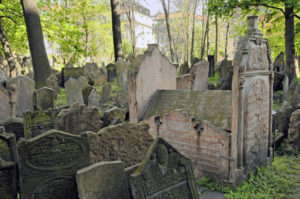
Mordecai Maisel’s Grave in Josefov (Photo by Don Knebel)
Jews began living in Prague during the tenth century. When Church leaders announced that Christians should not touch Jews, Prague’s Jewish residents were forced to live in a separate walled area near Old Town Square. In 1389, a pogrom launched by Prague’s clergy on Easter killed about 3000 Jews living in this ghetto. Residents of the ghetto were required to bury their dead in a small cemetery inside the walls. By the early sixteenth century, conditions were better in Prague than in other cities and Jewish intellectuals came to Prague’s ghetto from throughout Europe, creating a golden age of Jewish culture. Mordechai Maisel, a wealthy philanthropist who became the ghetto’s mayor, built synagogues for the new arrivals and erected a Jewish town hall. Residents continued burying their dead, up to twelve bodies deep, in the cemetery originally intended for a much smaller population. In 1781, Emperor Joseph II, the son of Maria Theresa, lightened restrictions on Prague’s Jews, allowing burials outside their cramped ghetto. Grateful residents named the area “Josefov” in Joseph’s honor.
As Nazis sent thousands of Prague’s Jews to concentration camps, Hitler ordered the historic buildings of Josefov preserved for a planned “Museum of an Extinct Race” and transferred Jewish artifacts from around Europe to Prague for his museum. Today, those buildings and artifacts constitute a museum complex honoring the Jewish history of Prague. Among the six Josefov synagogues open to visitors is the sobering Pinkas Synagogue, with the names of 77,297 Czech and Moravian victims of the Holocaust inscribed on its interior walls. Another highlight is the old Jewish cemetery, containing 12,000 jumbled stones and monuments. One of the largest marks the grave of Mordecai Maisel.
Comments are closed.